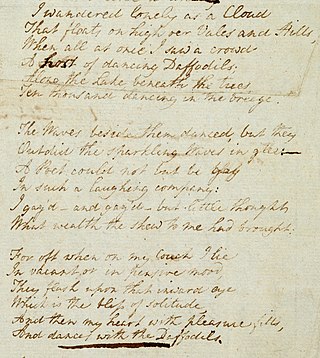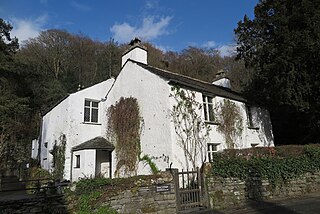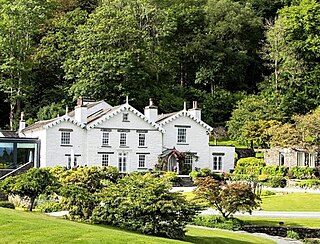
William Wordsworth was an English Romantic poet who, with Samuel Taylor Coleridge, helped to launch the Romantic Age in English literature with their joint publication Lyrical Ballads (1798).

Dorothy Mae Ann Wordsworth was an English author, poet, and diarist. She was the sister of the Romantic poet William Wordsworth, and the two were close all their adult lives. Dorothy Wordsworth had no ambitions to be a public author, yet she left behind numerous letters, diary entries, topographical descriptions, poems, and other writings.

"I Wandered Lonely as a Cloud" is a lyric poem by William Wordsworth. It is one of his most popular, and was inspired by an encounter on 15 April 1802 during a walk with his younger sister Dorothy, when they saw a "long belt" of daffodils on the shore of Ullswater in the English Lake District. Written in 1804, this 24 line lyric was first published in 1807 in Poems, in Two Volumes, and revised in 1815.

Grasmere is a village and former civil parish, now in the parish of Lakes, in the Westmorland and Furness district of Cumbria, England, and situated in the centre of the Lake District and named after its adjacent lake. Grasmere lies within the historic county of Westmorland. The Ambleside and Grasmere ward had an estimated population of 4,592 in 2019. William and Dorothy Wordsworth, the 'Lake Poets', lived in Grasmere for 14 years and called it "the loveliest spot that man hath ever found."

Rydal Mount is a house in the small village of Rydal, near Ambleside in the English Lake District. It is best known as the home of the poet William Wordsworth from 1813 to his death in 1850. It is currently operated as a writer's home museum.
The Lake Poets were a group of English poets who all lived in the Lake District of England, United Kingdom, in the first half of the nineteenth century. As a group, they followed no single "school" of thought or literary practice then known. They were named, only to be uniformly disparaged, by the Edinburgh Review. They are considered part of the Romantic Movement.

The Wordsworth Trust is an independent charity in the United Kingdom. It celebrates the life of the poet William Wordsworth, and looks after Dove Cottage in the Lake District village of Grasmere where Wordsworth and his sister Dorothy Wordsworth lived between 1799 and 1808. It also looks after the majority of the surrounding properties in the conservation area of Town End, and a collection of manuscripts, books and fine art relating to Wordsworth and other writers and artists of the Romantic period. In 2020 it introduced the brand name Wordsworth Grasmere.

Wordsworth House is a Georgian townhouse situated in Cockermouth, Cumbria, England, and in the ownership of the National Trust. It was built in the mid-18th century. William Wordsworth was born in the house in 1770. The house is a Grade I listed building. It is open to the public as a writer's house museum from March to October each year.
Robert Samuel Woof was an English scholar, most famous for having been the first Director of the Wordsworth Trust, which looks after Dove Cottage and runs the tourist attraction now known as Wordsworth Grasmere in Grasmere, the Lake District, Cumbria. Dove Cottage is known as the centre for British Romanticism movement, having been the home of William Wordsworth from 1799 to 1808.

Rydal Water is a small body of water in the central part of the English Lake District, in the county of Cumbria. It is located near the hamlet of Rydal, between Grasmere and Ambleside in the Rothay Valley.

Dove Cottage is a house on the edge of Grasmere in the Lake District of England. It is best known as the home of the poet William Wordsworth and his sister Dorothy Wordsworth from December 1799 to May 1808, where they spent over eight years of "plain living, but high thinking". During this period, William wrote much of the poetry for which he is remembered today, including his "Ode: Intimations of Immortality", "Ode to Duty", "My Heart Leaps Up" and "I Wandered Lonely as a Cloud", together with parts of his autobiographical epic, The Prelude.

Grasmere is one of the smaller lakes of the English Lake District, in the county of Cumbria. It gives its name to the village of Grasmere, famously associated with the poet William Wordsworth and his sister Dorothy Wordsworth, which is immediately to the north of the lake.

Rydal Hall is a large detached house on the outskirts of the village of Rydal, Cumbria, in the English Lake District. It has an early nineteenth-century front facade, but includes some earlier fabric.

Rydal is a village in Cumbria, England. It is a small cluster of houses, a hotel, and St Mary's Church, on the A591 road midway between Ambleside and Grasmere.
Dorothy "Dora" Wordsworth was the daughter of poet William Wordsworth (1770–1850) and his wife Mary Hutchinson. Her infancy inspired William Wordsworth to write "Address to My Infant Daughter" in her honour. As an adult, she was further immortalised by him in the 1828 poem "The Triad", along with Edith Southey and Sara Coleridge, daughters of her father's fellow Lake Poets. In 1843, at the age of 39, Dora Wordsworth married Edward Quillinan. While her father initially opposed the marriage, the "temperate but persistent pressure" exerted by Isabella Fenwick, a close family friend, convinced him to relent.

St Oswald's Church is in the village of Grasmere, in the Lake District, Cumbria, England. It is an active Anglican parish church in the deanery of Windermere, the archdeaconry of Westmorland and Furness, and the diocese of Carlisle. The church is recorded in the National Heritage List for England as a designated Grade I listed building. As well as its architectural interest, the church is notable for its associations with the poet, William Wordsworth and his family, and for its annual ceremony of rushbearing.

Greta Hall is a house in Keswick in the Lake District of England. It is best known as the home of the poets Samuel Taylor Coleridge and Robert Southey.

Allan Bank is a grade II listed two-storey villa standing on high ground slightly to the west of Grasmere village in the heart of the Lake District. It is best known for being from 1808 to 1811 the home of William Wordsworth, but it was also occupied at various times by Dorothy Wordsworth, Dora Wordsworth, Thomas De Quincey, Samuel Taylor Coleridge, Thomas Arnold, Matthew Arnold and Canon Hardwicke Rawnsley, a co-founder of The National Trust. It is now owned by the National Trust and is open to the public.

The Samling Hotel near Windermere is a building of historical significance and is listed on the English Heritage. It was built as a villa in about 1780 by John Benson who was the landlord of William Wordsworth. It was the home of several famous tenants over the next century and became a tourist attraction, being described in the Guide Books of the Lake District. The ownership of the house remained with the Benson family until about 1960. Today it is a hotel which has accommodation and dining facilities.

Fox Ghyll or Foxghyll, earlier Fox Gill, is a historic house near Ambleside in Cumbria, England, and is a Grade II listed building. It is a Regency building which seems to have been added to a much older house that was on the site. It was the home of many notable people including Thomas De Quincey over the next two centuries.
















